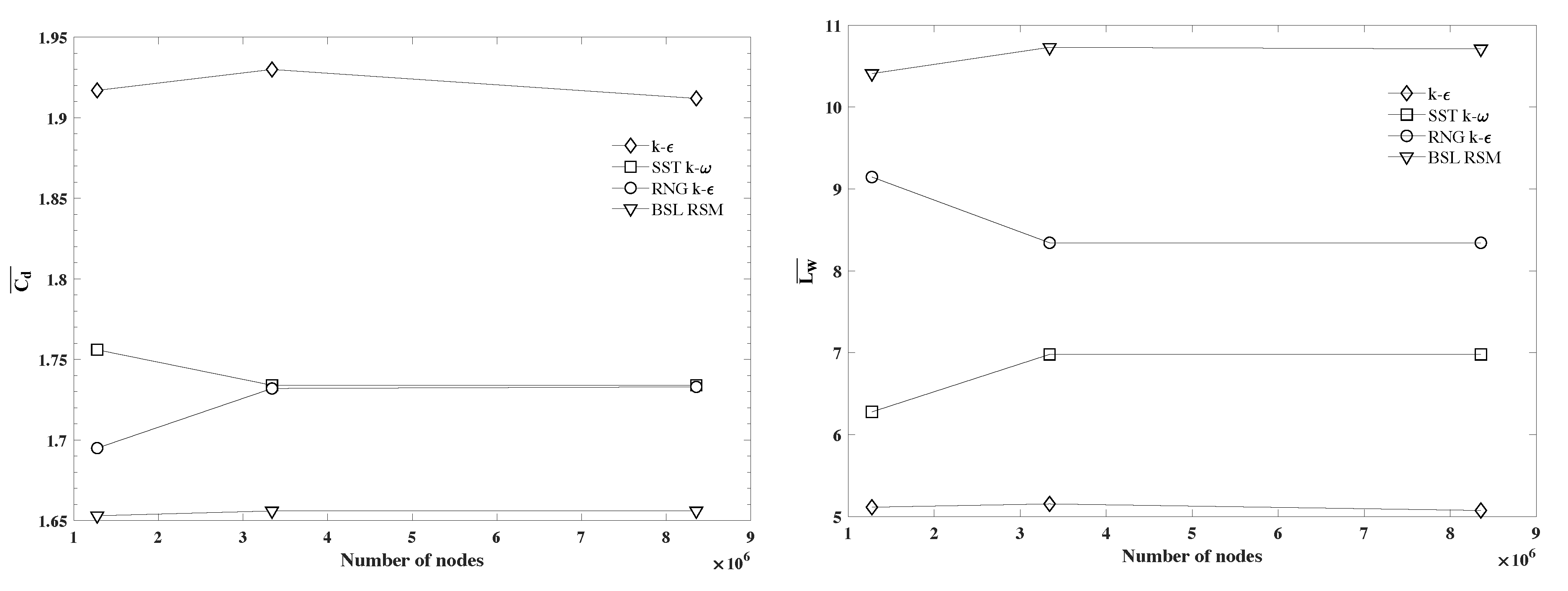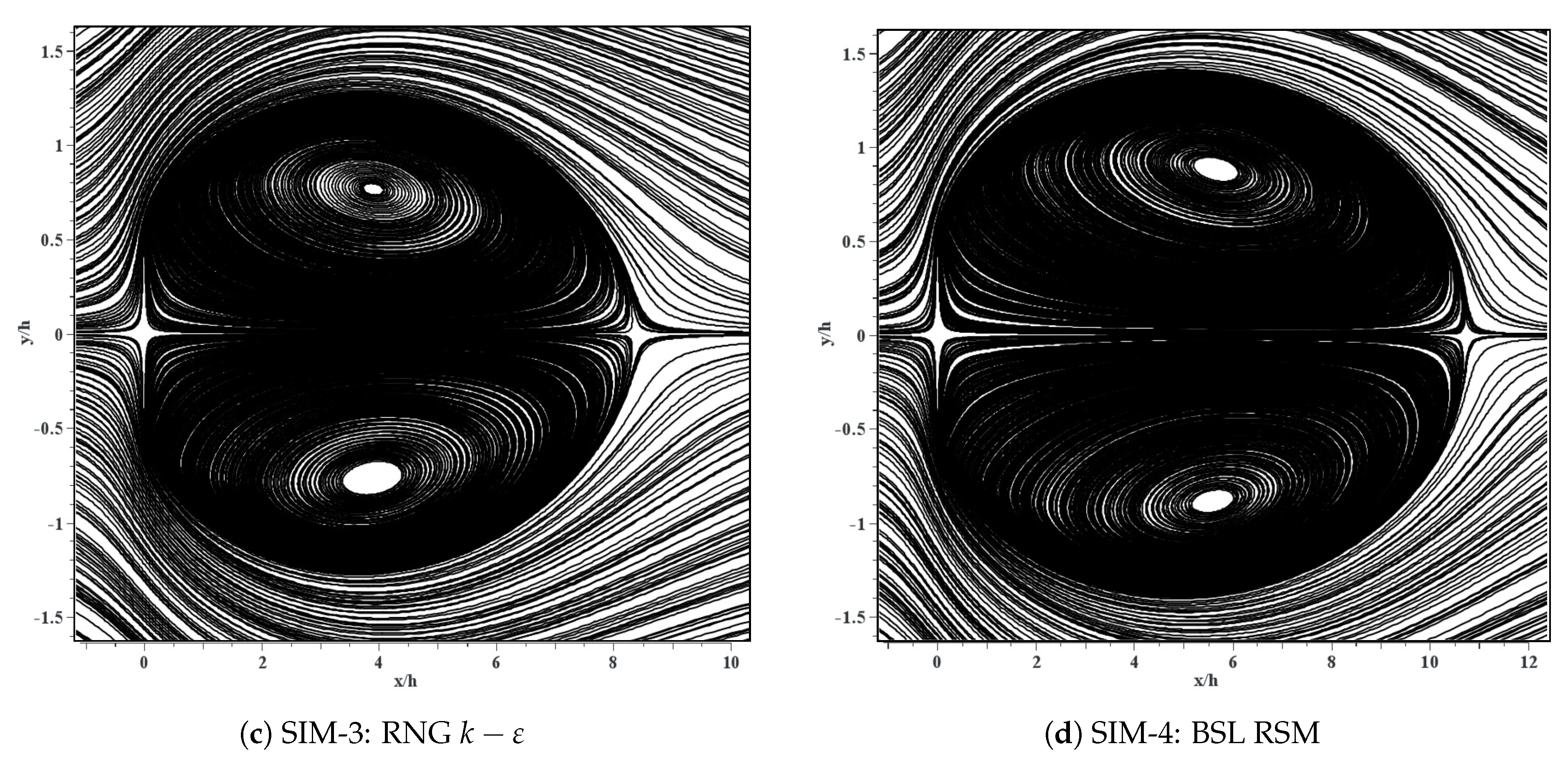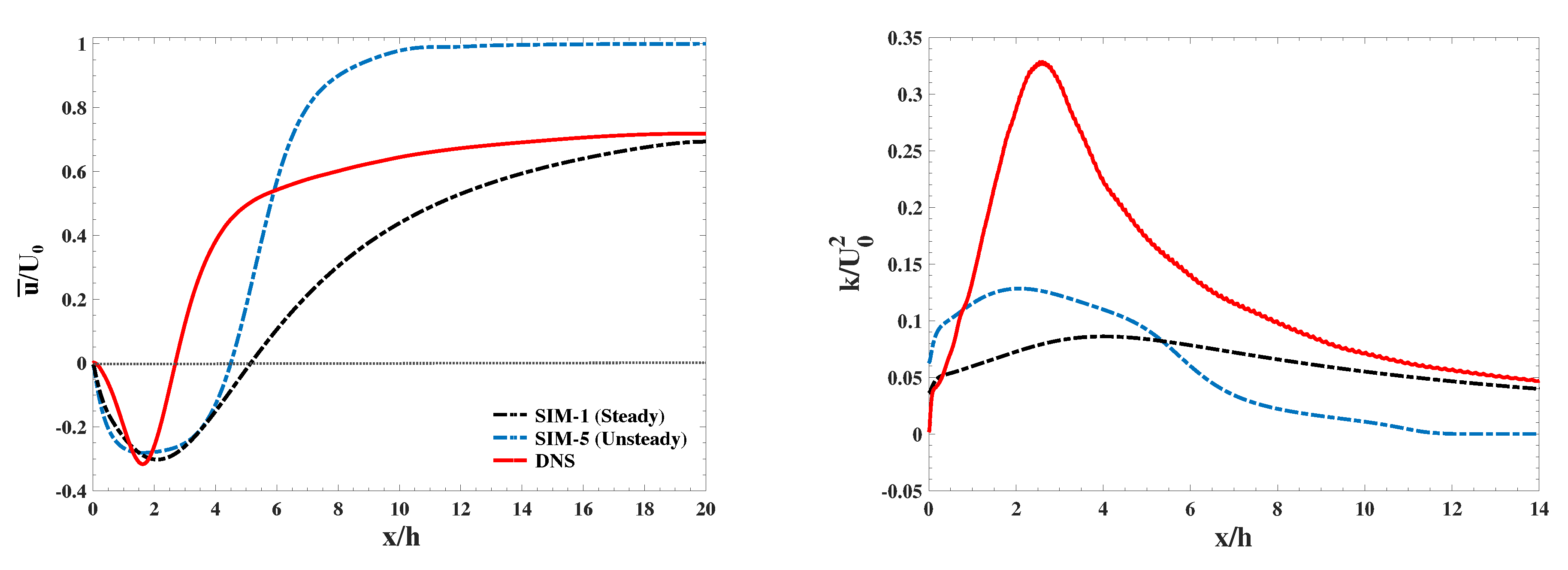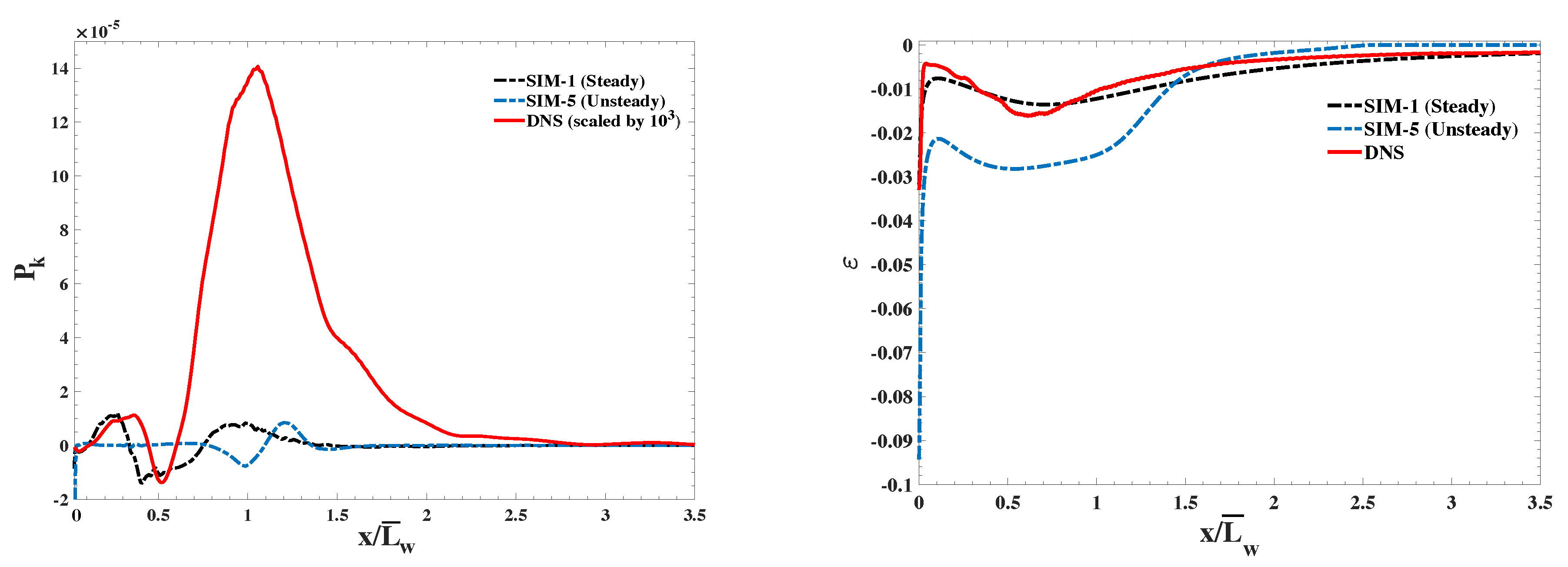1. Introduction
The flow structures formed behind bluff bodies generate a recirculating flow region that is referred to as the “wake”. This phenomenon has been extensively examined both numerically [
1,
2,
3,
4,
5] and experimentally [
6,
7,
8]. Flat plates are one of the simplest geometries that produce a fundamental wake for testing turbulence models and numerical schemes [
5]. Moreover, flat plates represent the geometrical shape of Photovoltaic (PV) modules, the market for which is increasingly growing. Accurate simulation of wind flows over PV modules is a key part in optimizing PV systems, especially rooftop-mounted PV modules in urban areas. Wind loads can cause damages to PV panel and thus data monitoring is critical [
9]. The complex and multi-directional nature of the wind in such environment makes it difficult to predict the resultant wake behind sharp-edge bluff bodies, such as buildings, PV modules and terrains [
10]. Furthermore, correct prediction of wind flow in complex terrains, where large pressure gradients are expected, is crucial in improving the performance of wind farms, safe placement of PV modules due to wind loads and modeling the wake of buildings in urban communities. For example, accurate prediction of wind loads on PV modules is especially relevant at high latitudes where solar panels need to be rather tilted in order to work efficiently. The high angle between the panels and the rooftops results in large aerodynamic forces on solar panels, which in turn causes a structural safety issue that require strengthening of the roof. In these situations, the installation cost of the system can get as high as ≈50% of the PV system [
11]. Therefore, the implications of using an appropriate means for predicting wind loads and wind flow forecasting in general, is enormous in the renewable energy industry. Moreover, accurate prediction of the wake formed behind PV modules and wind loads on large arrays play a crucial role in architecture of solar farms and large-scale solar energy system implementation in urban communities. Here, we focus on using the wake of a flat plate as a simple and fundamental flow to examine the performance of five turbulence models in predicting critical wake features. Thus, we provide a benchmark on the accuracy and applicability of these models in predicting the flow in complex settings and large pressure gradient environment.
The wind loads on PV modules can be estimated by numerical simulations based on Direct Numerical Simulations (DNS) [
2,
12,
13], LES [
5,
14,
15] and Reynolds Averaged Navier-Stokes (RANS) [
16,
17,
18,
19,
20], or by experiments [
8,
21,
22,
23]. PV modules are often represented by thin flat plates, with a certain value of aspect ratio (
) defined as the ratio of the plate height to width. The studies on the wake of thin flat plates have mainly focused on analyzing the changes in the flow topology and wake structures and flow characteristics such as recirculation length, drag and vortex shedding frequency. Most experimental studies are restricted to high Reynolds numbers of
, where
is the freestream velocity,
h is the plate height and
is the fluid viscosity. DNS studies are mostly limited to low
s (
) due to the extensive computational costs at higher
. Numerical studies based on LES, however, enable increasing the
to moderate to high ranges (
). Moreover, studies using RANS models extend the range of
by modeling complex features of the flow instead of solving for them as in the case of LES and DNS [
19]. Despite the simple geometry of a flat plate, when it comes to comparing numerical and experimental results, the literature highlights crucial discrepancies in predicting accurately the wake properties. This lack of agreement amongst experimental and numerical studies has been attributed to wind tunnel scaling issues for the former [
24] or strong
effects, boundary conditions, turbulence modeling and computational domain size for the latter [
5]. Therefore, it is important to have a benchmark on how different numerical tools, that is, turbulence models, perform in predicting such complex flows despite the simple geometry of a sharp-edge flat plate.
The studies of wind loading on PV modules can be classified into two categories: roof-mounted and ground-mounted PV panels. Both categories can be subjected to wind-related structural failures, especially when the system experiences multi-directional and turbulent wind flow during extreme wind events. Beside the influence of incident wind angles of attack, the tilt angles of PV panels can also affect the lift and drag forces (pressure distributions) under wind loading on the panels surface. These studies included numerical [
17,
18,
19,
20] and experimental [
21,
22,
25,
26] investigations of the wind load based on the flow around PV panels for different angles of attack (
to
) and different tilt angles of PV panels. Based on unsteady RANS simulations of the wind load around a ground-mounted PV module with
panel tilt angle and different incident wind directions (
to
at
increments), Jubayer and Hangan [
19] found that the maximum wind loading (drag, lift and overturning moments) were localized near the leading edge of the panel for all incident wind directions. The critical wind directions were
and
for the maximum drag and maximum uplift respectively; and
and
for the maximum overturning moments, which the authors attributed to the asymmetric properties of the flow (wake structures and mean pressure distributions) along the panel centreline. Jubayer and Hangan [
19] also compared numerical results with wind tunnel measurements by Abiola-Ogedengbe et al. [
22] and reported an agreement within 46%. The experimental results of Abiola-Ogedengbe et al. [
22] encompassed the same effects on the wind loading for critical wind angles of attack and the asymmetry of pressure distributions along the wake streamwise centerline for tilt angles of
and
. Furthermore, Abiola-Ogedengbe et al. [
22] reported that surface pressure on the PV module surface increased with the panel tilt angles, while Stathopoulos et al. [
25] stated that the influence of panel inclination can be significant only for critical incident wind angles of attacks. In addition to study of the influence of wind direction and panel inclination on PV module wind loads, Bitsuamlak et al. [
27], Shademan et al. [
18] and Warsido et al. [
21] also studied the effect of spacing parameters on wind loading and the resulting sheltering effects over an array of solar panels. These studies suggested that the sheltering effect caused by upwind PV panels reduced the wind loads on downwind PV panels when they were arranged in tandem.
The first reliable numerical study of the flow around normal flat plates was by Jahromi et al. [
28] based on two-dimensional simulations. Hemmati et al. [
29] performed a detailed three-dimensional DNS study to investigate the wake of a normal flat plate for a range of aspect ratios, including the infinite span plate, at
. Their study showed that wake characteristics changed for different aspect ratios:
, representing a typical array of solar panels (scaled);
representing a single solar panel; infinite span panel, representing a large array or bounded array of solar collectors. More recently, Hemmati et al. [
5] expanded their study by evaluating the source of discrepancy between LES and DNS simulations for this flow. Fifteen simulations with varying grid resolution, computational domain size and boundary conditions were performed to investigate their effect in the wake dynamics and also the differences amongst existing numerical and experimental studies. They validated their DNS results at
with experimental and numerical studies corresponding to
1000. This led to the conclusion that the discrepancies observed in the literature at
1000 regarding flow features such as pressure distribution on the plate leeward face are induced by strong
effects. Furthermore, it was shown that LES method over-predicted the mean drag coefficient and under-predicted the mean recirculation length. This deviation was related to the inability of LES model to capture negative production of the turbulence kinetic energy (
k) in a small region immediately behind the body.
Tian et al. [
15] used LES to study flow normal to a flat plate at
. The study included two different cases; one in which the plate had rounded off corners based on the curvature of a radius
(where
h is the plate height) and the other based on a radius
. The results showed unsteadiness in the flow pattern, which switched between high and low drag regimes. This switch was more frequent for the case with sharper corners, hence indicating that sharp corners increase the mean drag on the plate and the kinetic energy in the near wake. Another LES study [
30] investigated the flow around a flat plate at
. Two different flow angles were examined: normal plate and plate inclined at
. This study concluded that the present methodology could be used in engineering applications to predict the effect of wind gust on the wake of sharp-edge bluff bodies despite differences with existing DNS and experimental results.
The wake of an infinite span thin flat plate is unsteady with a low frequency secondary flow [
8,
29,
31]. The effect of the secondary flow on wake dynamics is complex and leads to three different periods of vortex shedding. During the period of low-drag, labeled as Regime L (for Low Amplitude) by Hemmati et al. [
29] and Najjar and Balachandar [
31], the recirculation region is elongated due to extension of the shear layer, the vortex shedding is suppressed and drag values decrease. The wake loses its coherence and the vortex roll-up is moved away from the panel. The shorter-periods of higher-drag (Regime H—for High Amplitude—based on References [
29,
31]), occurs when the extended shear layers collapse and force the structures to move towards the panel. This shortens the recirculation region, enhances the pressure drop and magnifies the drag coefficient. Once the secondary effects are propagated out of the near wake region, the wake returns to its natural state with a moderate drag value (Regime M—for Moderate Amplitude—according to Reference [
29]). The complexity of the wake of infinite span flat plates despite its simple geometry makes it an interesting bluff body to investigate, particularly regarding the performance of turbulence models.
RANS models have been used to predict wind loads on solar panels in a number of studies. Particularly, these studies focused on ground-mounted panels [
32,
33] and rooftop-mounted panels [
34]. The comparisons were high-level validation-based analysis with experimental results and they lacked extensive review of the simulation results. For example, Roy et al. [
35] compared Detached Eddy Simulation (DES) and RANS models in simulating the wake of a square cylinder at
. Their findings suggested that RANS models have major difficulties in capturing the correct mean recirculation length. Moreover, it was identified that RANS models severely under-predicted the turbulence production. Although there is substantial literature on RANS models and their overall behavior for different flows, there are no major studies, to the authors knowledge, that focus on the performance of RANS models in predicting complex wakes with large pressure gradients in comparison to DNS simulations. Such conditions are common in wind forecasting over complex terrains, which is crucial in wind energy industry.
This paper aims at providing detail information on performance of steady and unsteady RANS models in evaluating the wake dynamics of normal thin flat plates with infinite span. The study focuses on determining main wake characteristics, such as mean recirculation length, drag coefficient, pressure distributions and profiles of velocity and stresses for each turbulence model. The results are compared with DNS results of Hemmati et al. [
5,
29]. This study is to serve as a benchmark in identifying the limitations of conventional steady and unsteady RANS models in accurately predicting the wake of sharp-edge bodies and complex terrains with large pressure gradients. The problem description is presented in
Section 2, followed by the results and comparison of the model performances in
Section 3. A summary of the main findings are reported in
Section 4.
2. Problem Description
This study investigated the performance of different RANS and Unsteady-RANS (URANS) models on predicting the characteristics of a uniform flow around a normal thin flat plate with infinite span. This geometry corresponds to a large array (36 modules) of panels placed normal to the flow. The angle of inclination for the modules was selected as normal to horizontal axis for two reasons: (1) to examine the performance of RANS and URANS models in predicting a complex wake involving secondary flows (low frequency incidents) that lead to large unsteady variations and large pressure-gradients [
31] and (2) the most critical design criteria with respect to wind loading and drag. Thus, this platform provides insight into the performance of RANS models in design of infrastructure for PV modules installations.
The computational domain for the present simulations is defined in a three-dimensional Cartesian coordinate system, which is shown in
Figure 1, with a rigid stationary thin flat plate located at the origin. The
x-axis is in the streamwise direction,
y-axis in the chordwise direction and
z-axis in the spanwise direction. The rigid flat plate has a height of
h and its thickness is that of the smallest spatial grid.
The computational domain was designed following Najjar and Balachandar [
31] and Hemmati et al. [
29], in which the domain extended from
to
in the streamwise (
) direction with the plate located at the origin, from
to
in the chordwise (
) direction and
to
in the spanwise (
) direction. The streamwise distance between the plate and outlet boundary allows for flow re-development (recovery) after the wake region. The inlet boundary is located
upstream of the plate, which is sufficient to prevent artificial acceleration of the flow [
5]. The recommended spanwise size is
, which allows capturing three-dimensional features of the flow [
2] and the plate is extended across the entire span of the domain.
An in-homogeneous spatial grid compiled of unstructured hexahedron elements (
Figure 1) is used for these simulations. The computational grid is refined in area of interest to accurately capture major wake phenomena such as vortex structures and shear layers that are dominated by large velocity and pressure gradients. Thus, the finest elements are placed around the plate and in the near wake. Furthermore, the plate thickness was that of the smallest element in the
x-direction, in order to represent a thin flat plate without any reattachment effects in the flow. The non-uniformity of the grid followed strict guidelines to avoid large element skewness and grid quality issues. Moreover, the grid quality was ensured to be sufficiently high by checking main grid parameters such as orthogonal angle, expansion factor and aspect ratio. For the unsteady case, the temporal grid was set such that the maximum Courant number (CFL) does not exceed 0.48.
The RANS and URANS equations [
36] are computed using five different turbulence models—(SIM-1) Standard
, (SIM-2) SST
, (SIM-3) RNG
, (SIM-4) BSL RSM and (SIM-5) Unsteady
. The details of the turbulence modeling formulations for the aforementioned models can be found in References [
37,
38,
39,
40]. The discretization of Navier Stokes equations is based on a finite-volume approach. ANSYS CFX was used as the main solver. High resolution schemes, which are second-order accurate and bounded are used for advection fluxes, viscous terms and turbulence numerics. The convergence criteria for the simulations was defined by the residual momentum root mean square value, which was set to
. The simulations were completed using 6 CPUs and 64 GB of memory.
Grid Independence Analysis
A quantitative grid independence analysis from twelve simulations was completed to confirm the results are grid-independent. Three different grids with the same in-homogeneous grid distribution and quality were designed for this analysis: Grid 1 with
elements, Grid 2 with
elements and Grid 3 with
elements. The mesh-sensitivity study was based on two parameters, the mean drag coefficient (
) that is mainly dominated by the pressure differences and the mean recirculation length (
). The results from the mesh independence analysis for each turbulence model are displayed in
Figure 2.
The differences of both
and
obtained by the finest grids was less than
, which allowed us to consider the intermediate grid (Grid 2) as the appropriate grid for the simulations. Since we use the same grid distribution as that of Hemmati et al. [
5] and based on an their extensive grid and boundary condition sensitivity analysis, the observed differences of ≤1% constitutes grid-independence for these simulations.
4. Conclusions
The performance of steady and unsteady RANS models was studied in simulating the near wake of an array of PV modules, represented by normal thin flat plate with infinite span. The results obtained from the RANS models, which are based on eddy viscosity approximation, were compared to a companion DNS [
29].
The results from steady RANS models revealed the challenges of different models in predicting the wake feature of an infinite span thin flat plate. Comparing the results with DNS, the similarity appeared in the prediction of global features of the mean flow with a symmetric recirculatory region. However, the shear layer roll up at the edges (flow streamline angles) and the recirculation length were not accurately modeled compared to DNS. Amongst the models tested here, RNG model performed the worst in predicting mean wake features, whereas the Standard model provided the closest results to DNS. Thus, this study provided benchmark results indicating the limitations and inaccuracies of steady RANS models in predicting mean flow features due to large pressure gradients, similar to those of complex terrains in wind forecasting. These difficulties were partly attributed to the underlying linear Eddy Viscosity approximation in these models and partly to unsteady nature of the vortex shedding process.
The initial hypothesis that properly capturing the unsteady features of the wake assists in accurate modeling of the flow was also tested using Unsteady RANS model. Even though improvements were identified in the prediction of mean drag ( compared to 2.13 from DNS), the reported mean recirculation length was overestimated in length and width compared to DNS. However, the results were significantly improved compared to the steady RANS model predictions. Moreover, the turbulence kinetic energy, which was higher than the one predicted by the steady case, remained lower than that of the DNS. Thus, the initial hypothesis was only partially confirmed with more accurate prediction of mean drag, which is attributed to accurate modeling of the pressure field, significant improvements in predicting the mean recirculation length and the wake velocity field. However, there are still significant deviations from DNS results that may hint at the limitations of linear eddy viscosity approximation in modeling complex wakes with major unsteady features. The production of turbulence was severely underestimated by all models, compared to the DNS, while the dissipation was relatively similar. The deficiencies of traditional RANS models in accurate estimation of velocity gradients in the wake of infinite span flat plates are attributed to the limitations of linear eddy viscosity approximation and the steady-based nature of RANS formulations in modeling the highly unsteady vortex shedding process behind flat plates.
These results illustrate that conventional RANS models are not sufficiently accurate in predicting the wind loads on arrays of PV modules. Moreover, they fall short in accurately simulating high pressure-gradient wakes that are commonly observed behind buildings in urban wind engineering applications and wind flow over complex terrains in rural communities. Thus, improvements to RANS formulations and special treatments of the models per case basis, are needed to accurately model wind loads on PV modules and arrays of solar panels. Improvements to RANS formulations, such as non-linear eddy viscosity models, enable better architecture of effective solar farms and large-scale solar energy systems.





















